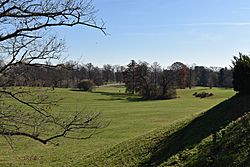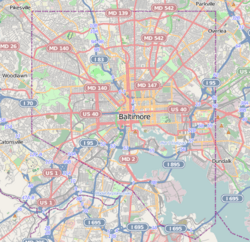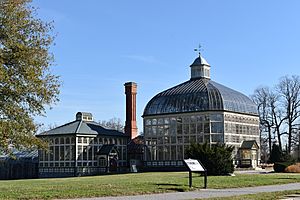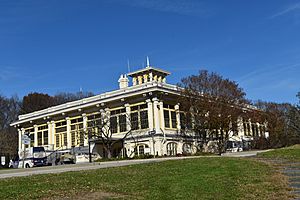Druid Hill Park facts for kids
Quick facts for kids Druid Hill Park |
|
|---|---|
| Auchentorlie | |

The Lawn in Baltimore's Druid Hill Park
|
|
| Location | Baltimore, Maryland |
| Created | 1860 / 1908 |
| Operated by | Baltimore City Department of Recreation and Parks |
|
Druid Hill Park Historic District
|
|
| Location | Druid Lake, Druid Hill Park, Baltimore, Maryland |
| Area | 746 acres (302 ha) |
| Built | 1860 |
| Architect | Howard Daniels; George A. Frederick (municipal architect) |
| Architectural style | Late Victorian styles |
| NRHP reference No. | 73002183 |
| Added to NRHP | May 22, 1973 |
Druid Hill Park is a huge, 745-acre (3.01 km2) green space in northwest Baltimore, Maryland. It's like a giant backyard for the city! The park is surrounded by Druid Park Drive to the north, Swann Drive and Reisterstown Road to the west and south, and the Jones Falls Expressway / Interstate 83 to the east.
Opened in 1860 by Baltimore's Mayor Thomas Swann, Druid Hill Park is one of the oldest planned public parks in the United States. It's in the same league as famous parks like Central Park in New York City and Fairmount Park in Philadelphia.
Contents
Park's Story: How It Began
The land where Druid Hill Park now stands was once a large private estate called "Auchentorlie." It belonged to Dr. George Buchanan, who helped create Baltimore Town in 1729. His estate was huge, covering about 579 acres (234 ha) of what is now the park.
Later, the estate was renamed "Druid Hill" by Colonel Nicholas Rogers. In 1860, the City of Baltimore bought this land from Rogers' family. The money came from a special one-cent tax on nickel horsecar rides. Mayor Thomas Swann helped make this happen.
Druid Hill Park officially opened on October 19, 1860. It's now listed on the National Register of Historic Places, which means it's a very important historical site. Many local people call it "Dru Hill" Park, which even inspired the name of a popular music group!
Who Designed the Park?
The park was designed by Howard Daniels, a landscape designer. John H. B. Latrobe helped design the park's entrances and changes to the old Rogers family mansion. This mansion is now called the "Mansion House" and is used by the Maryland Zoo.
George A. Frederick, a young Baltimore architect, designed many fun buildings in the park. These included the Chinese Station and the Moorish Station, which were stops on a small train that used to run through the park.
Nature and Changes Over Time
The northern part of the park has some of the oldest forests in Maryland. This area was left natural and was never landscaped. Roads in this section have been closed to cars since the 1970s, but they are still great for hikers and bikers.
Druid Lake, a large lake in the park, was built in 1863. It was one of the biggest lakes made with an earthen dam in the country. For many years, it held drinking water for Baltimore. In the early days of automobiles, people even used the park's winding roads to learn how to drive!
Many old fountains and ponds in the park have dried up, letting nature take over. But you can still see parts of their original structures.
Fairness in the Park
When Druid Hill Park first opened in 1860, some areas like pools and tennis courts were separated based on race. This meant that black and white people could not use the same facilities.
In 1917, the American Tennis Association, an organization for black tennis players, held its first national championships in Druid Hill Park.
On July 11, 1948, a group of 24 black tennis players bravely challenged these unfair rules. They played on the "white-only" tennis courts and were arrested. Their names are now honored on a marker near the Rawlings Conservatory. A famous Baltimore writer, H. L. Mencken, spoke out against these unfair rules in the newspaper. This event was an important step towards equal rights in the city.
Fun Things to Do

Druid Hill Park is a busy place with lots of activities!
- The Druid Hill Farmers' Market is held at the Rawlings Conservatory. It offers free concerts, kids' activities, yoga, and workshops from June to September.
- The park hosts the Charm City Cyclocross bicycle race every September. It's a big event for bike riders on the East Coast.
- Since 2014, the annual Charm City Folk and Bluegrass Festival takes place each April. It's a great event for music lovers!
Staying Healthy in the Park
In 2007, Baltimore added outdoor exercise equipment to the park. You can find rowing machines, ellipticals, and leg presses around the park's reservoir. These machines are free for everyone to use.
Important Statues and Monuments
The park has many statues that honor important figures.
- The Wallace Monument is a tall statue honoring William Wallace, a Scottish hero from the 14th century.
- The Wagner Monument is dedicated to a famous German composer.
- A statue of Christopher Columbus overlooks the reservoir.
- A statue of George Washington is placed near a main driveway.
Park Attractions
Today, Druid Hill Park is home to many exciting attractions:
- The Maryland Zoo: This zoo, one of the oldest in the U.S., opened in 1876. It has over 2,000 animals!
- The Howard Peters Rawlings Conservatory and Botanic Gardens of Baltimore: This beautiful building, built in 1888, has a historic Palm House and an Orchid Room filled with amazing plants.
- The Baltimore Model Safety City: Here, kids can learn how to be safe pedestrians by walking in a tiny model of downtown Baltimore.
- A large disc golf course: It has 18 holes, with more being built in the woods.
- Historic shelters and unique pavilions: These old buildings add charm to the park.
- Sports facilities: You can find swimming pools, tennis courts, and ballfields for different sports.
- Jones Falls Trail: This trail for hiking and biking runs through the park, circling Druid Lake.
Special Buildings in the Park
Druid Hill Park has 22 buildings that are protected because of their historical importance. Here are a few:
- Engineer's House (built 1894): This building is now home to the Baltimore City Department of Recreation and Parks.
- Mansion House (built 1801): This is the only building left from the original Rogers estate. It's now part of the Maryland Zoo.
- Maryland House (built 1876): This building was first shown at an exhibition in Philadelphia and then moved to the park. It's also part of the Maryland Zoo.
- Superintendent's House (built 1872): This "Stone House" is now home to the Parks and People Foundation.
Images for kids


























